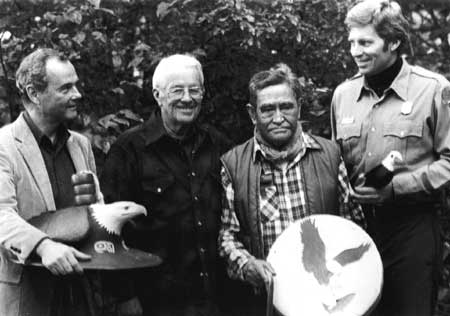|
Alaska Subsistence
A National Park Service Management History |

|
Chapter 6:
MANAGING ALASKA'S SUBSISTENCE PROGRAM, 1985-1989 (continued)
H. Glacier Bay Subsistence Conflicts
Many of the subsistence issues that took place within Alaska's NPS units were decided, or at least discussed, by members of the various park or monument subsistence resource commissions. But several issues surfaced at so-called standalone preserves (i.e., preserves that were not associated with a park or monument of the same name), and issues also occasionally arose within the "old" (i.e, pre-ANILCA) parks. [169] The most contentious such issue during this period related to the legality of subsistence hunting and fishing in Glacier Bay National Park.
On the surface, the issue appeared to have been clearly resolved. As has been noted in Chapters 3 and 4, the NPS, along with the Hoonah Tlingit and the Bureau of Indian Affairs, had wrestled with the issue for more than three decades, beginning in the late 1930s. But in early 1974, the issue was seemingly decided when Glacier Bay National Monument's chief ranger, Charles Janda, contacted Hoonah Mayor Frank See and informed him that the Code of Federal Regulations' prohibition against the killing of wildlife in National Park Service units applied to Glacier Bay as well. Neither the mayor nor other Hoonah residents appear to have protested that action, and for the remainder of the decade only scattered protests reached the ears of Park Service officials. [170] During the years that immediately preceded the passage of the Alaska Lands Act, it appeared that Hoonah residents were far more concerned over other overarching issues—fighting clear-cut logging on Tongass National Forest lands that surrounded their village, making land selections pursuant to ANCSA, organizing the Huna Totem Corporation, and dealing with the closure of the Inian Islands fishing grounds to the town's seine fleet—than Glacier Bay subsistence matters. The final Alaska Lands Act, moreover, did not include any language that altered the existing prohibition against subsistence uses in the newly-designated Glacier Bay National Park; in fact, sections 203 and 816(a) of the act specifically appeared to reinforce the status quo. The agency's General Management Plan for the park and preserve, released in 1984, was clear on the topic: citing Congressional Record language, it noted that "lands and waters within the national park area ... are closed to subsistence uses." [171]
During the mid-1980s, however, actions by both an international agency and the ADF&G had the (perhaps unintended) effect of raising subsistence issues once again. In 1986, the United Nations Educational, Scientific and Cultural Organization (UNESCO) designated Glacier Bay and nearby Admiralty Island as a "biosphere reserve" as part of its International Man and the Biosphere program. This designation heightened agency awareness of the special nature of park resources, and perhaps as a result, NPS officials mulled over the idea of reducing or eliminating commercial fishing in the park. That same year, however, the state's fish and game department was immersed in a study of Hoonah residents' subsistence uses. That study, for which interviews were conducted in the spring of 1986, pointed out that at least some of the Hoonahs' subsistence harvesting took place in Park waters, and as a logical follow-up to that study, the local fish and game advisory board proposed that the State of Alaska Board of Fisheries issue subsistence permits for Glacier Bay. [172] NPS officials protested the action, claiming both ANILCA's prohibition against subsistence uses and a lack of state jurisdiction in the waters of Glacier Bay. Perhaps as a result of that protest, the Board of Fisheries turned down the local advisory board's proposal. [173]

|
| In 1969, NPS officials stated that George Dalton, Sr. (second from right) was one of only two true subsistence hunters using the waters of Glacier Bay. In September 1986, NPS officials visited Hoonah and met with him. They included Regional Director Boyd Evison, Director William Penn Mott, and Glacier Bay Superintendent Mike Tollefson. NPS (AKSO) |
Hoonah residents raised the issue again in the fall of 1988 during public hearings about the park and preserve's wilderness plan. The following spring, the state fisheries board took up the residents' cause and determined that they were entitled to catch salmon in Glacier Bay National Park according to their "customary and traditional use." Soon afterward, ADF&G Commissioner Don Collinsworth began issuing them subsistence permits for Glacier Bay and Excursion Inlet. NPS officials were clearly alarmed by the state's action and, in late May 1989, they implored the ADF&G commissioner to stop issuing subsistence permits. Collinsworth, however, proved stubborn, and issued 80 subsistence permits; NPS officials, in response, posted boating regulations at various points in Hoonah. A month later, Tlingit leaders announced their intention to sail a flotilla into Glacier Bay and fish in several of the bay's salmon streams. Just a day before the confrontation, however, the ADF&G opened up a new seining area in Hawk Inlet (east of Hoonah and outside of the park), and Hoonah residents responded to the state's action by sailing away from Glacier Bay in favor of the newly-opened area. The confrontation was averted. But that fall, many Tlingits showed a renewed militancy toward the issue, and as the decade came to a close, the long-term status of Glacier Bay subsistence harvesting seemed murky and tenuous. [174] As Chapter 8 relates in greater detail, the issue remained active until well into the 1990s.
| <<< Previous | <<< Contents >>> | Next >>> |
alaska_subsistence/chap6g.htm
Last Updated: 14-Mar-2003